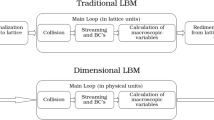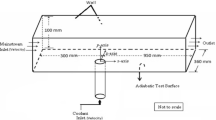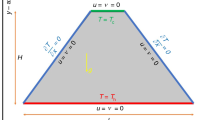Summary
This study presents the numerical calculations of the fluid flow and turbulent heat transfer characteristics of hot flow over a sudden-expansion with cold air base mass injection. The turbulent governing equations are solved by a control-volume-based finite-difference method with power-law scheme, the well knownk-ε model, and its associate wall function to describe the turbulent behavior. The velocity and pressure terms of momentum equations are solved by the SIMPLE (Semi-Implicid Method for Pressure-Linked Equation) method. In this study non uniform staggered grids are used. The parameters interested include the inlet Reynolds number (Re), inlet temperature (T0), and the injection flow rate (Q). The numerical results show that the reattachment lengths are reasonably predicted with a maximum discrepancy within 9.1%. It also shows that the base mass injection suppresses the horizontal velocity and turbulence intensity. In these high temperature heat transfer characteristics, the heat transfer coefficient increased with increasing inlet temperature and inlet Reynolds number, but decreased with increasing injection flow rate of the cooling air.
Similar content being viewed by others
Abbreviations
- C 1,C 2,C μ :
-
turbulent constant
- E :
-
constant
- G :
-
generation rate of turbulent kinetic energy
- H :
-
channel height at inlet
- i :
-
turbulence intensity
- k :
-
turbulent kinetic energy
- Nu:
-
local Nusselt number
- q ″w :
-
heat flux
- Re:
-
Reynolds number
- S ϕ :
-
source term
- T :
-
temperature
- T 0 :
-
inlet temperature
- TI :
-
turbulent intensity
- U 0 :
-
inlet velocity
- U τ :
-
friction velocity
- U,V :
-
x, y component velocity
- \(\overline {u\upsilon } \) :
-
Reynolds shear stress
- X τ :
-
reattachment length
- y + :
-
dimensionless distance from the wall
- ϕ:
-
dependent variables
- Ή φ :
-
diffusion coefficient ofφ equation
- α:
-
thermal diffusivity of fluid
- ρ:
-
density
- κ:
-
von Kármán constant
- σ:
-
turbulent Prandtl number
- μ:
-
dynamic viscosity
- ν:
-
kinematic viscosity
- τ w :
-
wall shear stress
- ε:
-
turbulent energy dissaption rate
- λ:
-
length scale constant
References
Aung, W., Goldstein, R. J.: Heat transfer in turbulent separated flow downstream of a reward-facing step. Isr. J. Technol.10, 35–41 (1972).
Aung, W., Watkins, C. B.: Heat transfer mechanism in separated forced convection. In: Turbulent forced convection in Channels and bundles, 1, pp. 233–257. New York: McGraw-Hill 1979.
Eaton, J. K., Johnston, J. P.: A review of research on subsonic turbulent flow reattachment. AIAA Journal19, 1093–1100 (1981).
Kim, J., Kline, S. J., Johnston, J. P.: Investigation of a reattachment turbulent shear layer flow over a backward-facing step. ASME J. Fluids Engng.102, 302–308 (1980).
Schetz, J. A., Nerney, B.: Turbulent boundary layer with injection and surface roughness. AIAA J.15, 1288–1293 (1977).
Groot, W. A.: Laser Doppler diagnostics of the flow behind a backward-facing step. Ph. D. Thesis, Georgia Institute of Technology, 1985.
Lin, J. T., Armaly, B. F., Chen, T. S.: Mixed convection in buoyancy-assisting, vertical backwardfacing step flow. Int. J. Heat Mass Transfer33, 2121–2132 (1990).
Isomoto, K., Honami, S.: The effect of inlet turbulence intensity on the reattachment process over a backward-facing step. ASME J. Fluids Engng.111, 87–92 (1989).
Oyakawa, K., Koike, T., Mabuchi, I.: Studies of heat transfer control by using jet discharge at reattachment region downstream of a backward-facing step. JSME59, 543–549 (1993).
Yang, J. T., Tsai, B. B., Tsai, G. L.: Separated-reattaching flow over a backstep with uniform normal mass bleed. ASME J. Fluids Engng.116, 29–35 (1994).
Yang, Y. T., Kuo, C. L.: Numerical study of a backward-facing step with uniform normal mass bleed. Int. J. Heat Mass Transfer40, 1677–1686 (1997).
Aung, W.: An experimental study of laminar heat transfer downstream of backsteps. J. Heat Transfer105, 823–829 (1983).
Tsou, F. K., Chen, S. J., Aung, W.: Starting flow and heat tranfer downstream of a backward-facing step. J. Heat Transfer113, 583–589 (1991).
Sparrow, E. M., Kang, S. S., Chunk, W.: Relation between points of flow reattachment and maximum heat transfer for regions of flow separation. Int. J. Heat Mass Transfer30, 1237–1246 (1987).
Vogel, J. C., Eaton, J. K.: Combined heat transfer and fluid dynamic measurements downstream of a backward-facing step. J. Heat Transfer107, 922–929 (1985).
Filetti, E. G., Kays, W. M.: Heat transfer in separated reattached, and redevelopment regions behind a double step at entrance to a flat duct. J. Heat Transfer88, 131–136 (1967).
Seki, N., Fukusako, S., Hirate, T.: Turbulent fluctuations and heat transfer for separated flow associated with a double step at entrance to an enlarged flat duct. J. Heat Transfer98, 588–593 (1976).
Yang, J. T., Tsai, C. H.: High temperature heat transfer of separated flow over a sudden-expansion with base mass injection. Int. J. Heat Mass Transfer39, 2293–2301 (1996).
Launder, B. E., Spalding, D. B.: The numerical computation of turbulent flows. Comp. Meth. Appl. Mech. Engng.3, 269–289 (1974).
Jayatilleke, C. L.: The influence of Prandtl number and surface roughness on the resistance of the laminar sublayer to momentum and heat transfer. Prog. Heat Mass Transfer1, 193–329 (1969).
Patankar, S. V.: Numerical heat transfer and fluid flow New York: McGraw-Hill 1980.
Author information
Authors and Affiliations
Rights and permissions
About this article
Cite this article
Yang, Y.J., Yan, Z.S. & Chen, C.K. Numerical study of turbulent heat transfer and flow characteristics of hot flow over a sudden-expansion with base mass injection. Acta Mechanica 144, 57–69 (2000). https://doi.org/10.1007/BF01181828
Received:
Issue Date:
DOI: https://doi.org/10.1007/BF01181828




